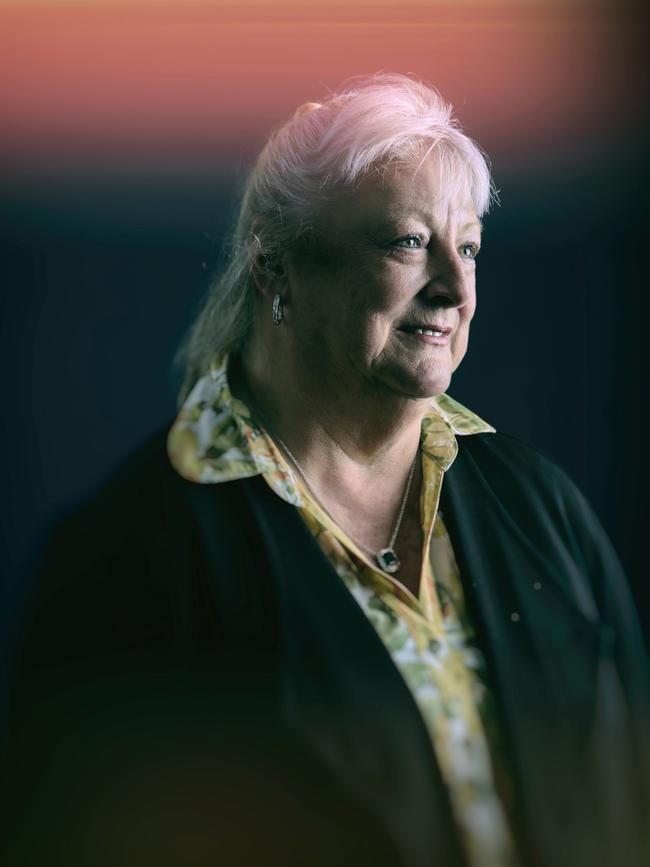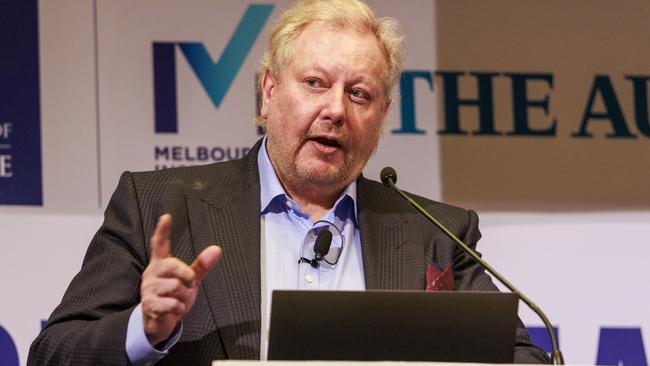From friends to founders: Maree Isaacs and Richard White’s journey
For the first time, the intensely private Maree Isaacs reveals how she met WiseTech’s rock’n’roll frontman Richard White and went on to building a $30bn tech empire.

One of Australia’s most successful, yet little-known, business partnerships began at a time when corporate leaders would chainsaw boardroom tables in half to make their point.
It was 1987 and Richard White – fresh from a stint ensuring the stage lighting didn’t trip the power to the poker machines at Gold Coast’s Jupiters Casino – was doing some computer consulting work at Sydney radio station 2MMM.He was in the station’s office when its famously flamboyant owner Rod Muir theatrically took a chainsaw to the boardroom table after clinching a deal to sell the business to Glenn Wheatley and the Heine brothers, following acrimonious negotiations.

This article is from The List — Australia’s Richest 250, published March 15, where Isaacs is ranked in the top 175.
“I was there working on the computers the day it all happened. He got the chainsaw out and cut the table in half with everyone in the room. They were all saying, ‘What the hell is going on?’ It was madness,” White recalls with a chuckle. “I suppose it was an act of corporate rebellion. It was quite something to see.”
The timing of White’s stint at the station was fortuitous for another reason. Also working in the office at that time was Maree Isaacs, reporting to finance director Trish Richards, who would later help her cousin Neil Perry start the Rockpool restaurant business.
“When I came in to do their computer work it was Maree that I met,” White says. “I did a number of service calls there, and we became friends, and then a bit more than friends for a time. And then I eventually convinced her to leave Triple M.”


White and Isaacs have been working together ever since – White as the lively Sydney-based boss of logistics software giant WiseTech Global, and Isaacs in Brisbane as the executive director behind the scenes keeping the business running smoothly for three decades.
For the first time, White and the intensely private Isaacs are discussing how they met and went on to build one of Australia’s most successful technology companies and ASX floats in recent history – and why they’re still working together as WiseTech celebrates its 30th anniversary.
Isaacs may be one of Australia’s most successful tech founders, but she keeps an extremely low profile. She has worked with White for the best part of 37 years at WiseTech and before that at his Clear Group and their Real Tech Systems Integration.
She is now WiseTech’s head of licence management and its company secretary, having also previously been in charge of business and administrative operations, account management, customer service and quality assurance.
-
“Maree and I fit together perfectly because she is incredibly good at getting things done”
-
Isaacs and White each have significant shareholdings in the business, enough for both to place among the ranks of the Richest 250 this year.
“Maree and I fit together perfectly because she is incredibly good at getting things done, and I’m the creative that sees the future,” White tells The List.
“So I hand over a lot of things to her. It is a bit different now that the company is so large, but I would say, ‘This is what I have imagined, this is how we are going to build it, and now this is how we are going to make it happen.’ And she would pay the creditors, collect the debts, organise the staff. She is very operational and unassuming and gets things done. I’m very noisy, out there making promises, and she would just ground it all.”
Isaacs remembers White as a “very interesting guy with an amazing vision” who would come into Triple M to teach her how to use a particular software system.
“Richard is a great person to work with,” she says. “Having invested in his business in the very early days, before we co-founded WiseTech, I’ve had a vested interest to help those businesses succeed.
“At WiseTech we have a great product, however, we don’t sit back and say we have done well and that is enough. Like Richard, I strive to make a difference in the world and the lives of our employees, customers and potential customers.”
When the history of WiseTech is discussed, it is usually about White’s enthusiasm for music and his background in rock’n’roll. It is a passion that drips from the walls of his Bexley house in suburban Sydney – the home he grew up in that he has now revamped. Famous guitars and paraphernalia from legends such as Prince, David Bowie and Pink Floyd adorn the walls.
There is also a link from music and sound all the way through to WiseTech, featuring several stops and serendipitous moments along the way, such as meeting Isaacs at 2MMM then some other key people who have stuck with White ever since.
As a youngster, White started working in the family events business, which was based in two ballrooms within their historical Bexley home. He would wash dishes, fetch drinks and, as he got older, wait tables. After playing in Sydney bands during the 1970s, he started repairing guitars and then, armed with some welding skills, built stage and venue lighting equipment.
The equipment venture was a success, and White had to move facilities four times as it grew. But he grappled with all the growing pains small companies face, such as cashflow, paying wages and dealing with debtors and creditors. Margins were tight, so the solution was to merge with a bigger business called Jands, where White became research and development manager.

He built a lighting control system – a computer-controlled mixing panel. “I had no idea how hard it was meant to be to do this,” he remembers. “And then I had to learn programming, and I did. But I was so impassioned by this, and I remember being up all night working on this product the night we won the America’s Cup in 1983. I was just completely in love with computers by then.”
White sold his shares in Jands in 1985 (he bought back into it in 2017) then worked at Jupiters Casino, keeping the power on for the poker machines whenever there was a big show that used a lot of lighting.
After that, and the consulting stint in Sydney, White started computer distribution business Clear Group. “That got very big, very quickly,” he says, “but the problem was that I wasn’t designing or creating anything. It was a lot of revenue but was not creative. So I sold that in 1989 and started a business called Real Tech Systems Integration.”

By then Isaacs was working alongside White in the business, which provided computer consulting and systems integrations services. One day, White ran into some freight forwarders who needed some software systems integrated.
“I remember thinking it was all pretty ordinary stuff, not really a coordinated integrated system,” White says. But he figured it was an industry that he could make money in, by fixing and upgrading logistics systems for small and medium businesses.
He bought a $295,000 house in Sydney’s Newtown and was paying an eye-watering 18 per cent mortgage interest rate. To help pay his bills, he took a job in Huntington Beach, California, where he built a fulfilment system.
White arrived back in Australia six months after receiving a phone call from New Zealander Paul Hawkings of Datahawk, who wanted to sell a freight forwarding system in Australia. He figured White could help.
White eventually bought Hawkings’ source code, rewrote a lot of it, and named this new product Deliverance. Eventually, the company became Eagle Developments International, which was later changed to CargoWise after White kept getting phone calls from builders asking if he was in construction. By 2011 it was WiseTech.
During this time, Isaacs’ behind-the-scenes work was vital to keeping the company going.
“In the whole history of WiseTech we have never made a loss,” White says.
“We made money the first year we were trading and we actually ran the company from the cash book, not from the P&L (profit and loss statement). We were just looking at the cashflows, looked at how much we had owing to us, how much we had to pay, what the wages were.
“And we knew we were in good shape because we always had a buffer of cash. No one goes broke because they’re not making a profit; they go broke when they run out of cash.
“I had looked over the precipice a couple of times before WiseTech and so I was very conscious about the need to ensure I had a buffer of money to keep the business running.”
“There’s always more to offer and more that we can do.” — Maree Isaacs
White says he also believed that if he could make a good product and demonstrate it, he could ask for big prices from customers.
By 1999 he had most of the big local freight forwarding companies as clients and had bought most of his smaller competitors.
He started thinking about going international, an idea that accelerated after he studied for a master’s degree in IT, doing most of the assignments on his own business.
“I remember getting a 90 – a high distinction – in one subject, and writing back to the lecturer asking how to get the other 10.”
It was then that White undertook what is known as a “skunkworks project”, effectively starting a new company inside the shell of an old one – working on a new and better product at one end of the room while the rest of the staff worked at the other end.
That product was released in 2004 and took WiseTech international, integrating freight software and custom rules and processes across countries and borders. But White wanted to keep growing and had big ambitions, as demonstrated by his acquisition of the company owned by a rival duo.
“We gave them 1.2 per cent of [our] company to buy the business,” White recalls. “I said at the time, ‘I’m going to make this a billion-dollar company.’ They said, ‘Oh, sure.’ But one was a great software developer and the other ran a lot of transport system businesses quite well. They retired quite wealthy with that share. It gave us some talent we didn’t have, and it gave them something that was life-changing.”
Even then, WiseTech was nowhere near that $1 billion valuation – but they’d also had a lucky escape. A few years earlier, an internet services provider that had been bought by a US firm offered White a $4 million all-scrip deal, escrowed for 12 months.
“I politely declined, but I guess I figured out that at the time Maree and I were worth $4 million. It sounded like play money, not real money. But six months later the [US] company was bankrupt and those shares they offered were worth nothing. I dodged a bullet there.”
White was later approached by two private equity firms, but resisted until it became clear he needed some capital to expand internationally.
This eventually led to White’s friend Rob Hopkins, founder of fund manager Smallco, introducing him to another private equity identity, Charles Gibbon from Quadrant.
Gibbon put in about $2.5 million to buy into WiseTech in 2005. Michael Gregg, then managing director of Health Communication Network, came in later with a $2 million investment. Both would join the board.
By the time WiseTech listed on the ASX in 2016, Gibbon’s stake was worth $70 million and Gregg’s almost $60 million. Their shareholdings are now worth more than $1 billion and about $800 million, respectively.

Another fortuitous meeting for White was a discussion he had with fellow billionaire Mike Cannon-Brookes of Atlassian in 2007. It was just before the global financial crisis, and the pair were discussing their respective payment models. White told Cannon-Brookes he charged the full fee upfront for his logistics software plus an annual 20 per cent maintenance payment. Cannon-Brookes countered that he charged less upfront but 50 per cent in annual maintenance.
White pondered this and decided to take it to a more extreme level: zero for the software but 100 per cent in fees.
One US executive quit WiseTech in disgust, but the software-as-a-service model was born. When the GFC struck and companies slashed their capital expenditure, WiseTech survived – and, in fact, thrived – from operational expenditure budgets.
Since then, White has radically overhauled the amount of software training WiseTech customers get from the company. Giving away the training modules for free led to a drop in revenue from training but a big lift in overall sales.
Meanwhile, they kept acquiring overseas rivals, survived an attack by short-seller J Capital in 2019, weathered the logistics sector grinding to a halt at the start of Covid, and rode the subsequent boom when it restarted.
Today, WiseTech is a $500 million revenue company worth more than $25 billion on the ASX.
And Isaacs has been there every step of the way. “There’s always more to offer and more that we can do,” she says.
“You can never stop improving. I’ve never been tempted to leave and do something else.”
Although there will be a celebration for the company’s 30th anniversary, White says there will be no boardroom table chainsaw-style stunts.
“It’s a great time to celebrate. It’s an event because it’s 30 years, but it’s just another year. We’ve got to look forward to five and 10 years from here, because there’s a lot more to do. There’s so many more things to build. There’s more problems to solve and there’s so much more opportunity to gain. We shouldn’t rest on our laurels and think that 30 years is something meaningful other than it’s a birthday.”







To join the conversation, please log in. Don't have an account? Register
Join the conversation, you are commenting as Logout